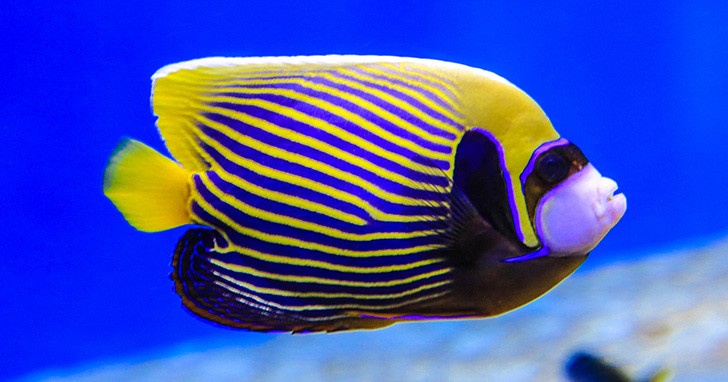Where does the Emperor Angelfish fish live naturally?
The Emperor Angelfish casts a striking look in marine aquariums even as a juvenile. They are born in many areas around the world including the Indo Pacific, African Coast, Red Sea, Japan’s Ogasawara Islands, and south to the Great Barrier Reef and New Caledonia. In nature they live in reef environments from 100-328 feet deep primarily among protected shallow coastal areas in caves or ledges.
Do juvenile Emperor Angelfish look the same as adult ones?
Juvenile Emperor Angelfish and adults have different color morphs. So much so, that juveniles were initially thought to be different fish altogether. They are black with circular white and blue stripes starting at the tail. As it ages, this Angelfish will vary in coloration and pattern as it transforms from juvenile to adult.
The adult Emperor Angelfish, also called the Imperator Angelfish, has a bold, blue body covered with bright yellow horizontal stripes culminating in a bright yellow to orange caudal fin. A striking blue-black mask covers the eyes, and a similarly colored vertical band extends from the pectoral fin two-thirds of the way up the body. This band is highlighted in a sapphire-blue in front, and bright yellow, caudally. The mouth of the adult is white. Both males and females exhibit similar coloration, although males may exhibit a darker mask, and females may lighten during courtship. In order to meet its needs, this moderately hardy Angelfish requires an aquarist with a moderate amount of experience.
What are the tank requirements for Emperor Angelfish?
This spectacular Angelfish requires a large living environment. An aquarium with a minimum capacity of two hundred and twenty gallons is required. Although it may live in a bonded male-female pair or harem set up in nature, it is recommended to keep only one in a home aquarium because males can be highly territorial, it does not do well with other fish of similar color and keeping more than one is prohibitive due to their adult size of fifteen inches. This species is a protogynous hermaphrodite, which means that females have the ability to take on the male role in the absence of one. The Emperor Angelfish is semi-aggressive and may bother peaceful fish but can tolerate smaller aggressive fish such as Dottybacks, Damselfish, and Wrasses. Avoid housing similarly colored fish with them and be sure to add them to the aquarium last, after others have claimed their territories. It also acclimates easier as a juvenile.
Pomacanthus imperator requires a high water quality for good health and to promote longevity. The aquarium should have sufficient hiding places like those that live rock provides. Live rock is also important because these Angelfish will feed on algae and microscopic foods found within the live rock. It is classified as reef safe with caution due to its habit of preying on small invertebrates and soft corals.
Water parameters for the Emperor Angelfish should be maintained at these levels: sg of 1.020-1.025, temperature of 72-78° F, dKH in the range of 8-12, and pH measuring 8.1-8.4.
What’s special about the Emperor Angelfish?
An enduring characteristic and another reason they add so much appeal to home aquariums is that they are known to produce a thumping or grunting sound when it feels threatened.
Are Emperor Angelfish easy to breed?
Emperor Angelfish have not been successfully bred in captivity. Even in nature, procreation is difficult because they are broadcast spawners, and most eggs are swept over the reef after fertilization.
How long does the Emperor Angelfish live in captivity?
They are believed to live up to thirteen years in captivity.
What does the Emperor Angelfish eat?
This member of the Pomacanthidae family is an omnivore and must be introduced into an established aquarium, as it grazes on live rock to meet part of its nutritional needs. They should also be fed a balanced diet of Spirulina, marine algae, high-quality Angelfish preparations, Mysis or brine shrimp, and other meaty items several times per day.
Angelfish as a whole are popular specimens for reef and marine aquariums and adding an Emperor Angelfish to their home tank and is the goal of many aquarists, due to their colorful presentation and striking patterns. Aquarists who have a moderate amount of experience should know that this spectacular specimen is within their reach. The next step is to research their care level and ensure they can meet the needs of the Emperor Angelfish.

